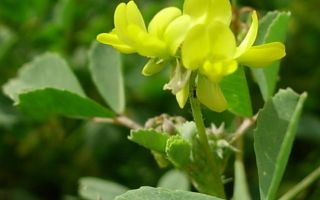Content
- 1 What does fenugreek look like and where does it grow?
- 2 The chemical composition and calorie content of fenugreek
- 3 Why is fenugreek useful?
- 4 Benefits of fenugreek for weight loss
- 5 How to make fenugreek tea
- 6 Fenugreek Traditional Medicine Recipes
- 7 The use of fenugreek in home cosmetology
- 8 Face masks with fenugreek
- 9 Fenugreek for hair health and beauty
- 10 The use of fenugreek in cooking
- 11 Fenugreek harm and contraindications for use
- 12 How to choose and store fenugreek seeds
- 13 Conclusion
- 14 Reviews
Many people think that they do not know this plant - and they are wrong. The aroma and taste of fenugreek is familiar to everyone who has dealt with the seasonings of hop-suneli and curry, which include it. The beneficial properties and contraindications of fenugreek are of increasing interest also thanks to its fame as a plant that "can replace all the medicines on the planet."
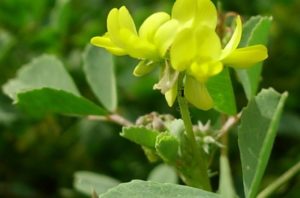
What does fenugreek look like and where does it grow?
Fenugreek has many names: it is called helboy in Egypt, as fengurek it is known in Germany, as chaman in Armenia, and in Russia as shambhala, sweet clover, burkun, chrestovik, mushroom grass.
Fenugreek (Trigonélla), or Helba (Foenum-graecum - ‘Greek hay’) is a plant of the legume family, a wild annual spicy shrub. Asia Minor is considered his homeland. It became widespread: even in Ancient Greece, the healing properties of "Greek hay" were known, and now the regions of its cultivation are Eastern Europe, Turkey, the Caucasus, Iraq, Egypt, Ethiopia.
The benefits of this culture as an exotic spice are highly valued in cooking: anyone familiar with the specific smell of curry can easily identify fenugreek by the aroma of coumarin, which is present in the seeds of the plant.
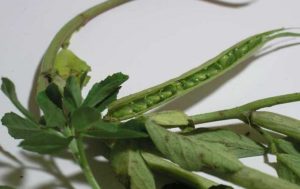
Of the 100 species of this culture, along with helba (hay fenugreek), another type of plant is also valued - blue fenugreek (which got its name from the blue flowers): the useful properties of the former are more used in folk medicine, and the latter - in cosmetology and cooking.
Fenugreek is also used for agricultural needs.
Hay fenugreek can even be grown as a houseplant in a pot, and it would be a good idea: useful for its medicinal properties, in the summer, it will also delight the eye with bright yellow and purple flowers.
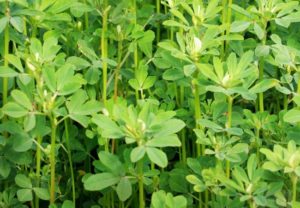
In the photo of the plant, you can see that outwardly wild fenugreek hay is presented in the form of a bush up to 60 cm high, with an even branched stem and small oval leaves, collected in clover-shaped triplets, as well as small fruits in the form of oblong pods with seeds of 4 mm.
The chemical composition and calorie content of fenugreek
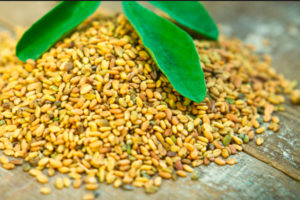
The most beneficial nutritional properties for the body in the fenugreek plant are its seeds, which contain a large amount of protein and protein.
The nutrient content based on the% of the average daily requirement (RDA) is:
- Protein: 23 g (38%);
- Carbohydrates, total: 58.35 g (20%);
- Fat: 41 g (10%).
The calorie content per 100 g of the product is 323 kcal.
|
Macro, microelements |
mg |
RSP,% |
|
Iron, Fe |
33.53 |
186 |
|
Copper, Cu |
1.11 |
111 |
|
Manganese, Mn |
1.23 |
62 |
|
Magnesium, Mg |
191 |
48 |
|
Phosphorus, P |
296 |
37 |
|
Potassium, K |
770 |
31 |
|
Calcium, Ca |
176 |
18 |
|
Zinc, Zn |
2.5 |
21 |
|
Sterols: |
||
|
Phytosterols |
140 |
47 |
|
Vitamins: |
||
|
Vitamin PP, NE |
8.16 μg |
41 |
|
Vitamin B6, Pyridoxine |
0.6 μg |
30 |
|
Cellulose: |
||
|
Alimentary fiber |
24.6 g |
123 |
Iron - promotes hematopoiesis, increased vitality.
Copper - assists in the transportation of iron.
Magnesium - Gives benefit in the absorption of calcium, as well as in strengthening cardiac and nervous activity, immunity.
Potassium - has the properties of maintaining fluid composition, helps the kidneys.
Vitamin B6 - anemia protector; regulator of glucose and assimilation of fatty acids, prevents the harm of the development of urolithiasis.
INitamine PP (nicotinic acid) has antioxidant, anti-inflammatory properties, stabilizes sugar levels, improves the functioning of the gastrointestinal tract and the brain.
In addition, Shambhala is rich in amino acids, which, in particular, due to its beneficial antidiabetic properties, are involved in enhancing insulin secretion.
Biologically active properties of fenugreek are reported by flavonoids and phytosterols.
Why is fenugreek useful?

- In addition to the inulin-stimulating properties of the rare amino acid 4HO-Ile, the benefits of fenugreek seeds also manifested themselves in the hypoglycemic effect - the ability to reduce the level of glucose and lipids in the blood, which is important in two types of diabetes mellitus.
Interesting! Research has shown that a fenugreek diet can lower glucose levels by up to 54% per day.
- Regular consumption of the plant is beneficial in eliminating heartburn, constipation, chronic inflammation of the intestines, ulcerative colitis. The beneficial properties of shambhala in cleansing the liver have also been proven.
- Fenugreek seeds are formulated with saponins, which are beneficial in inhibiting fat absorption by reducing the liver's production of harmful "bad" - low density cholesterol, while levels of "good" - high density cholesterol remain at the same level.
- Fenugreek has strong antibacterial properties that help with inflammation. Herbal teas with fenugreek seeds and lemon are useful for sore throat, colds, fevers.
- In combination with creatine, the benefits of fenugreek seeds are also manifested in enhancing endurance and are especially indicated for the body for athletes and physically active people, as well as for those who are undergoing a rehabilitation period after harm from injuries or serious illnesses.
- The properties of the polysaccharide galactamannan in fenugreek have an effect on reducing the likelihood of harming heart attacks.
- Medical research has established the properties of fenugreek in counteracting cancer.
For women
Since ancient times, one of the most common prescriptions for helba is the treatment of female diseases.
Fenugreek seeds have also been shown to be beneficial when consumed by lactating women to stimulate lactation and help them return to their prenatal form.
The beneficial properties of fenugreek are also known during labor - in the ability to reduce pain during labor and facilitate childbirth for a woman and a child and quickly restore the body. It will be useful to start taking it towards the end of pregnancy, if prescribed by a doctor.
The properties of fenugreek are also known to relieve cramps during menstruation and reduce hot flashes during menopause.
For men
The saponins in shambhala are believed to have a beneficial effect on testosterone production. In addition, since ancient times in the East, the benefits of fenugreek have been known as a powerful aphrodisiac capable of enhancing the properties of sexual desire and activity in men.
Benefits of fenugreek for weight loss
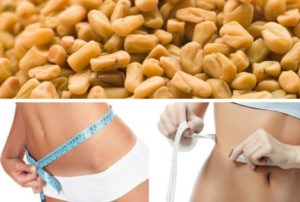
Given the benefits of the effects of Shambhala herb on the function of the digestive tract, it has found wide application as a means of reducing the harm of fat deposition in the body.
For this purpose, tea from the plant is used, which is included in the diet menu. The beneficial fat-burning properties of fenugreek for weight loss will not slow down to manifest itself not only by the escaped kilograms, but also by freeing the body from harmful toxins and toxins.
In addition, getting rid of the external manifestation of excess weight - cellulite - will be a pleasant "side effect". Fenugreek is also used for home wraps in the complex restoration of the body from the harm of excess weight.
For this purpose, fenugreek tea (helba) is mixed with stevia infusion in a ratio of 3: 1 and drunk immediately, and then they do not consume food and other drinks for at least 3 hours.
Enhancing the slimming effect: adding fenugreek to food.
Powdered seeds - ½ tsp. - added to food at one time.
More on the benefits of fenugreek for weight loss:
How to make fenugreek tea
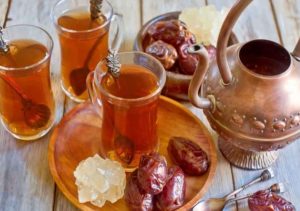
Helba yellow tea in Egypt is a traditional drink made from fenugreek seeds, famous for its health benefits.
Classic recipe:
- Washed and dried fenugreek seeds are ground into powder.
- 1 tsp powder is poured with one glass of boiling water and boiled for 5 - 7 minutes.
- Chilled to 60 aboutA small piece of finely chopped ginger, 1 tsp, is added to the broth to taste. honey, a piece of lemon.
Another option for helba tea is with the addition of milk.
The beneficial properties of the remaining fenugreek seed cake at the bottom can also be used as an additive to dishes or masks.
Tea has a peculiar bitter taste, which adds piquancy to it: in Ayurveda, this fenugreek bitterness is endowed with the beneficial property of removing excess mucus from the body.
Fenugreek Traditional Medicine Recipes
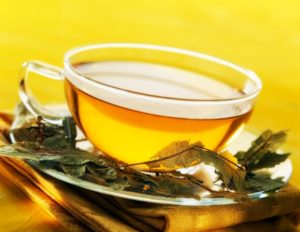
Fenugreek has been successfully used by traditional medicine of the East for a long time.
Helboy treatment is carried out with decoctions, infusions, ointments, compresses from well-dried and grated mature seeds. The herb harvested during the flowering period also benefits. Dry fenugreek, as it were, concentrates all its beneficial properties.
The antibacterial, anti-inflammatory and antifungal properties of fenugreek seeds are used as a first aid for burns, inflammatory processes in wounds, for the treatment of eczema. Its use helps to accelerate tissue healing.
To strengthen immunity
For the benefit of strengthening the immune system, recovering from a serious illness, relieving discomfort with colds and flu, a decoction is used.
- Fenugreek Seed Powder, 2 tbsp l., pour half a liter of cold water and leave to infuse for 3 hours.
- The infusion is brought to a boil, but not boiled.
- Filter and drink 3 - 4 times a day warm, 50 ml.
- You can add lemon and honey to taste.
The broth is also used for preventive purposes for all indications of the use of fenugreek.
The second option for treating immunity with fenugreek is seed germination.
For this purpose, seeds are wrapped in a piece of natural cloth soaked in water and placed under a light weight. Leave for 2 days, and then germinate without load to the desired size of the shoots.
Sprouted seeds are useful for breakfast with honey or as a cocktail with a little liquid.
For sore throats, colds and SARS
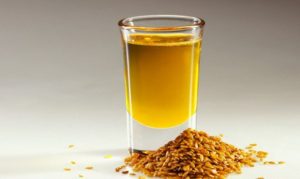
Helba has a useful warming property that is used in the form of compresses to treat sciatica, arthritis, pinched nerves, cellulite, and colds.
- Brew ground fenugreek seeds with water, 50 ml.
- Everything must be brought to a boil, but not boiled.
- Mix the cooled solution with 1 tsp. vinegar and abundantly moisten the sore spot.
- Cover the top with cling film and a towel to create a warming effect.
For a strong cough:
- Fenugreek seed powder, 1 tbsp l., a few dates and figs pour a glass of warm water.
- Keep everything in a water bath for up to 10 minutes. and cool.
- Strain and add 1 tsp. honey.
Drink 100 ml 2-3 times daily until symptoms relieve.
From sore throat:
- Seed powder, 2 tbsp l., pour half a liter of boiling water.
- Keep on low heat for 30 minutes.
- Insist 15 - 20 minutes.
- Strain the broth.
Use to gargle the throat 3 - 5 times a day, until recovery.
To increase male potency
Chinese medicine is well aware of the health benefits of fenugreek for men. The seeds are used primarily to increase potency.
To this end, helba tea is steamed according to the traditional recipe, filtered and a third of a glass of fat milk or cream is added to it.
Benefit will be brought by the use of helba every day, 2 times for 1 cup.
For skin diseases
For the treatment of skin problems - dermatitis, eczema, furunculosis, fistula, purulent ulcers, wounds, calluses - helba ointment is beneficial.
To do this, grind 2 tbsp. l. fenugreek seeds, add a small amount of water to the consistency of sour cream and put on low heat for 10 minutes. With constant stirring. The cooled agent is applied to a cotton swab or gauze bandage and wrapped tightly. The procedure is repeated 2 times a day.
With dermatitis, it will be useful not to use a bandage: it is enough to apply the ointment from the seeds of the plant to the skin for up to 2 hours, and then rinse. The course is 10 days.
For joint pain
Fenugreek seed powder, finely ground, 3 tbsp. l., pour half a liter of cold water and insist up to 3 hours. Then put on fire, bring to a boil and immediately filter. To enhance biological activity, add a few tablespoons of honey to the broth cooled to a warm temperature - to taste. Take 3 - 4 times a day, 50 ml, before meals. Infusion of seeds is beneficial for chronic arthritis.
From hemorrhoids
Treatment of hemorrhoids is carried out on the basis of eliminating the harm of the development of constipation, which serve as a background state of its development. Fenugreek raw materials have antispasmodic and anti-inflammatory properties that are beneficial in regulating bowel movements. For this purpose, 0.5 - 1 tsp. the seed powder is diluted with water and taken overnight. You can also stew the green leaves of the plant with water.
To prevent heartburn
For the gastrointestinal tract, fenugreek seeds have useful mucus-forming properties that relieve the effects of the harm of mucosal inflammation, manifested in the form of pain and heartburn. A simple remedy will bring benefits: 1 tsp. the seed powder is simply added to the meal.
To stimulate lactation
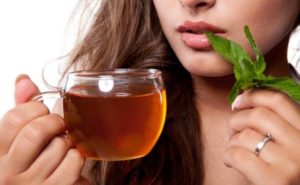
As an excellent stimulant of the hormone prolactin, which is responsible for the production of breast milk in nursing mothers, the use of fenugreek is beneficial in cases of harm caused by decreased lactation during breastfeeding.
An additional effect of this technique will be an increase in breast size and an increase in its elasticity. The prepared volume of tea is taken up to 4 times a day.
To strengthen the breast after lactation, fenugreek oil is also used: 5 - 7 drops of it are added to flax oil and lubricate the breast with massaging movements. With abundant rubbing, a contrast shower will be useful, which will wash away the remaining oil and additionally stimulate blood circulation.
For calming nerves and good sleep
Ayurveda offers a recipe for fenugreek jelly with milk, which will be useful as a sedative before bed.
2 teaspoons of fennel, cardamom and fenugreek seeds - grind in a coffee grinder, add chopped figs - 6 pcs. and dates - 10 pieces.All are poured with 2 glasses of water and boiled for 15 minutes, stirring occasionally and making sure that the mixture does not burn. At the exit, a thick porridge is obtained (with a larger volume of liquid, the consistency can be made more liquid if desired), which is cooled, interrupted with a blender and placed in the refrigerator. Before going to bed, take half of the resulting mass diluted with warm milk.
The benefits of such jelly and seeds are universal: it regulates the functioning of the nervous, respiratory and reproductive systems, and also has the ability to improve digestion.
With diabetes
Each meal contributes to a jump in blood sugar levels. The body has a mechanism for the production of the hormone insulin by the pancreas, which helps the cells store carbohydrates for their further transformation into energy, and fenugreek seeds have the beneficial properties of normalizing carbohydrate balance and lowering blood sugar levels.
To do this, soak 1 tsp in half a glass of water in the evening. fenugreek seed powder and leave until morning. The swollen gruel is interrupted with a blender. The drink is consumed once a day. The course of treatment is 14 days.
The second version of the recipe is simpler: bred 2 tbsp. l. fenugreek seeds with milk - 50 ml, mix well and take 1 time per day.
With anemia
To prevent the harm of anemia, grind 1 tsp. shambhala seeds powder is thoroughly mixed in 1 glass of warmed milk, add 1 tsp. honey. Consume up to 2 cups each day - until the hemoglobin level returns to normal.
The use of fenugreek in home cosmetology
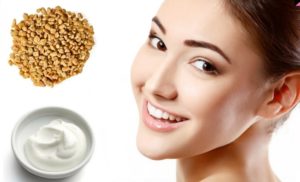
Fenugreek is a true beauty elixir. And this is not an exaggeration.
The plant was used in ancient Egypt. There are legends that Cleopatra used fenugreek seeds for her wonderful beauty products.
It's all about the composition, which gives unique beneficial properties.
Nicotinic acid and special mucus from the seeds endow the plant with the ability to effectively regenerate the skin, which has been used in the preparation of anti-aging preparations. Its properties to renew skin cells are so high that they work great against the formation of wrinkles, including mimic ones.
It is difficult to overestimate the list of useful cosmetic properties of preparations made from fenugreek seeds:
- fight against acne and skin inflammation;
- cleansing the epidermis;
- lightening pigmentation;
- protection from the harm of ultraviolet radiation;
- strengthening hair and preventing hair loss;
- elimination of dandruff;
- help in the prevention of premature gray hair.
To get the most out of your skin care products, include fenugreek seeds as a food supplement in parallel.
Face masks with fenugreek
Fenugreek seed face masks have long been known for their benefits to improve skin condition, regenerate and regulate oiliness. The fastest way is to use mucus, known for its cosmetic beneficial properties: just wipe or wash your face with water in which fenugreek seeds have been infused. The skin immediately becomes silky and smooth.
And the rest of the seeds can be used for masks.
Purifying mask
The first remedy that should be included with the benefits of cleansing the skin in morning beauty procedures is a facial scrub mask.
They prepare it simply:
1 teaspoon of fenugreek seed powder is mixed with 1 teaspoon of cream. Apply on face for 15 minutes and then wash off.
The powder will also be useful to mix with your daily skin care product (ideally, if it is of organic origin).
Daily use of the mask will not only help get rid of dead cells, but also accelerate the renewal of new, young ones, and also remove the harm of inflammation, acne, and rash.
Nourishing mask
1 teaspoon of fenugreek seed powder is mixed with the protein of a chicken egg, 1 teaspoon of honey, caraway seeds and olive oil are added. Stir to a homogeneous consistency and apply for 15 minutes. Then they are thoroughly washed off.
Moisturizing mask
In the previous base - 1 teaspoon of ground seeds and honey - add carrot juice and aloe juice in the same quantities (you can dilute the prepared aloe extract from the pharmacy with water). The composition is applied to the face for 20 minutes and then washed off.
Regenerating mask
Fenugreek seeds are steamed with boiling water and olive oil is added to them - until a thick gruel is formed. The composition is applied after pre-cleansing the face before going to bed. The minimum course is 1 week.
Fenugreek for hair health and beauty
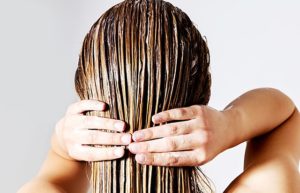
Fenugreek also has a wide spectrum of action for the benefit of hair. Due to the high concentration of protein in its composition, it is able to have a strengthening effect on the root and hair shaft against the harm of weakening hair, to restore their structure, make them smooth and shiny. In addition, the seeds of the plant have beneficial anti-seborrheic properties.
Hair strengthening agent
The mask is based on:
- cottage cheese - 200 g;
- honey - 1 tbsp. l .;
- egg - 1 pc.;
- fenugreek seed powder - a handful.
Mix the useful components into a homogeneous mass, apply and leave for 2 - 3 hours on hair wrapped in a towel. It is important to keep the mixture warm on your hair. Rinse off the mask with water and shampoo.
In addition to the antiseborrheic effect, the mask will benefit from a nourishing and tonic effect, restoring smoothness and shine to the hair.
Anti-dandruff mixture
The beneficial properties of shambhala seeds allow you to fight seborrheic phenomena, or dandruff. The real cause of dandruff is not just dryness of the head, but a whole range of factors that harm the scalp, one of which is the disruption of the sebaceous glands, or seborrhea itself - on the basis of malnutrition and metabolic processes, weakening of the immune system, body pollution, etc.
Antiseborrheic mask
For the composition, take 2 tbsp. l. seeds soaked overnight, grind them into gruel and rub into the hair roots. The mask is kept for 40 minutes, then washed off. Repeating the procedure 3 times a week brings benefits. The course is repeated as needed.
Anti-dandruff fenugreek and cottage cheese mask
You will need:
- Cottage cheese - 200 g;
- Fenugreek seed powder - handful;
- Warm water.
Steam the seed powder with warm water, mix with cottage cheese - until a creamy consistency is obtained. The mask is applied to the roots and left on the hair for 2 to 3 hours. Then wash off with warm water
It will be useful to carry out procedures once a week - for a month. The result will be a reduction in the harm of itching, restoration of the functions of the sebaceous glands, the improvement of hair follicles and the general strengthening of hair due to increased calcium content.
The use of fenugreek in cooking

Fenugreek is widely used by culinary experts both as seeds and as fresh and dry leaves. The aroma of shambhala has soft and unobtrusive notes, and the taste properties are similar to roasted hazelnuts.
Raw seeds of the plant are interesting in vegetables and soups. Green seeds taste like celery. Heat treatment gives them nutty and mushroom flavor notes.
Dried and roasted, fenugreek seeds are ground into a fine powder and used as a spice in dishes. Chalk dry leaves are also added to the powder to enhance the piquancy of the taste. Shambhala is included in the recipe of famous spices: adjika, curry, khmeli-suneli.
Blue fenugreek is famous for its property of imparting a delicate, soft taste to products: it will be useful to add it to pickles, fish and meat dishes, as an addition to soup.
It is blue shambhala that possesses the piquant smell of coumarin. However, fresh leaves do not have a pronounced aroma. Saturation takes on the smell of a dried plant.
The use of blue fenugreek in the manufacture of cheese has been known since the Middle Ages: the product served as a delicacy for aristocrats, and in Europe there is still a recipe for bread with a blue plant.
Fenugreek seeds are useful for thickening sauces, cream soups - due to their high starch content. It is also used in fondue and pasta recipes.
Recipe for a flavorful sauce with fenugreek for pizza or pasta
Tomato juice, 4 liters, boil down to half the volume, fry onion (1 pc.), Garlic (3 - 4 cloves) in vegetable oil, add apple juice (1 glass) to the pan. Mix with condensed tomato juice, into which a gauze bag with ½ tsp is dipped. fenugreek seeds, 7 peas of allspice, 6 sticks of cloves and infuse for 1 hour. Salted and sweetened.
In the east, chaman is widely used in sweets and pastries. This unique spice has special aromatic properties that give the desserts inimitable "oriental" aromas.
How to chop fenugreek at home
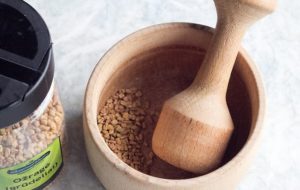
Powdered product is obtained from fenugreek seeds by fine grinding. However, making a thorough grind at home is not easy due to the hardness of the seeds: a powerful grinder will provide a useful service. The powder can also be purchased ready-made from supermarkets or organic food stores.
One way to grind fenugreek seeds is to pour overnight to soften them and then grind them in a mortar.
How to remove bitterness from fenugreek seeds
As noted, the fruits of blue fenugreek have not been widely used in cooking due to the fact that they are inferior in taste to the hay variety. But even helba seeds have a specific bitterness.
To eliminate it, they are soaked in water with the addition of soda and allowed to brew for 24 hours. During this time, the water needs to be changed several times.
The second way to eliminate bitterness is also beneficial - frying. Both the seeds and the grass are roasted. The pan must be dry. This method allows you to preserve the beneficial properties of fenugreek and enhance its spicy aroma.
The third way is to add fennel: this spice is able to interrupt the bitterness of fenugreek.
Application of fenugreek leaves
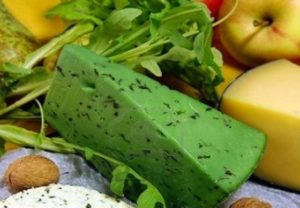
By adding fresh fenugreek leaves to salads, soups, meat, rice and vegetables, dishes create flavor.
In the Alps, with fenugreek leaves, according to special recipes, they prepare the green cheese famous for its beneficial properties, which has a specific aroma and pungent taste: it is not cut into pieces, but rather rubbed as a seasoning for dishes.
Collecting fenugreek leaves for food is carried out at the beginning of flowering and until the appearance of fruits: then the fibers become coarse and lose their beneficial properties, including taste.
Fenugreek greens are used advantageously as an additive to animal feed to increase milk yield.
Fenugreek harm and contraindications for use
Interestingly, according to medical research in 2011, no harm to the body from the use of fenugreek was found.
A useful plant has a modest list of contraindications associated with its phytoestrogenic function. It includes persons:
- with increased estrogen and prolactin (hyperestrogenism);
- with insulin-dependent diabetes;
- with blood clotting problems.
How to choose and store fenugreek seeds
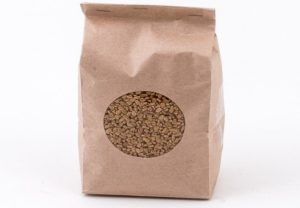
When choosing a spice, it will be useful to know that the shelf life of fenugreek without losing the valuable properties of whole grains is about 2 years in a glass container and in a cool dry place.
Ground fenugreek seeds have a more modest shelf life - up to 3 months.
To prevent the harm of buying a low-quality product, it is useful to make a visual inspection: the mixture should be homogeneous in composition and not have foreign inclusions.
Conclusion
The beneficial properties and contraindications of fenugreek were studied by Hippocrates, who believed that the power of this plant was comparable to a thousand medicines. Helba can really replace a home first-aid kit, since it has the ability to work with a whole range of diseases - from colds to cancerous tumors. Given the limited contraindications, the benefits of this unique green medicine man in the daily diet will manifest itself not only in improving well-being, but also in getting rid of many health problems.

